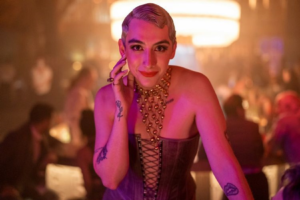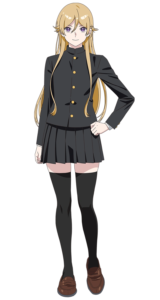Why Netflix’s Cowboy Bebop Doesn’t Have the Best Non-Binary Representation
Netflix’s Cowboy Bebop wasn’t as bad as I thought it would be, but that doesn’t necessarily mean that it was good either. I fully love and appreciate the fact that the music was kept the same, the intro heavily inspired by the original anime, and the stylistic costume changes for Faye Valentine (because, quite frankly, sometimes anime outfits don’t make sense outside of animation). But my biggest qualm is with the changes made to the character “Gren.” In the live-action, Gren is canonicly non-binary and is played by a non-binary actor (Mason Alexander Park); however, a lot of the nuances to the original character (and backstory of the character) are erased. Gren, in the live action, doesn’t get enough screen time to develop and becomes the “token enby” with very little substance.
In the original series, Gren was experimented on in prison with drugs that ended up giving him gynecomastia (enlargement of breast tissue). Although he struggled with it, he is very androgynous and comfortable in his sexuality and gender (there is no confirmation of him being gay, but he does mention that he does not enjoy being with women so there are interpretations of him being asexual or gay). He is very ambiguous with gender as he is now caught between the gender binary and what constitutes “typical” gender traits. Here is a picture of what he looks like in the animated series:

To someone that hasn’t watched the show, it would be hard to distinguish if this was a “man” or a “woman.” This is true for a lot of anime characters but what makes Gren especially interesting is that he went on a journey. He isn’t a “trap” character for comedic effect and he isn’t a “drag-queen” character written by someone who isn’t queer to mock the gay community. He is a character with a very complicated past that had to come to terms with his gender in the present and how he’d like to be viewed knowing that he has prominent breasts.
The Gren in the live-action completely ignores his backstory and attempts to “fix” his “tragic past” by neglecting to include it in the first place. And, in the end, we’re given this:

Now, this is not the only outfit they wear, there are more masculine-leaning outfits, but the presentation is more of a “flamboyant gay man” stereotype (flashy suit colors, skirts and corsets, lots of makeup, and no sense of fluidity, ambiguity, or otherwise). Gren’s character as well (although canonicly enby) has been turned into more of a token-homosexual-cast-member and less of an enby representation. There is no room for the ambiguity of the original character. Although it is true that there are various ways for enby people to represent themselves, (and they absolutely don’t owe anyone androgyny) this specific character alteration perpetuates a very specific “type” of queer character, especially considering that the actor mentioned this new version of the character “fixes” the old one.
What exactly is it fixing? Because all I see is a drastically different character that continues the media-representation of what it “means” to be queer with a new label slapped on like it’s a great hashtag. Although it is true that the original Gren is a 90’s character with the issues of the time, I find that he is still a much more interesting character than this side character. Changing Gren to be an intersex character as opposed to non-binary would’ve been more beneficial if Netflix wanted to “fix” the prison-backstory – but not if Netflix was still going to do this and turn him into a stereotyped gay.
The animated Gren explores what it means for someone AMAB (assigned male at birth) to perform gender after having his body physically altered. He isn’t a woman, doesn’t feel like a woman, but now has what would be only attributed to a “woman” and doesn’t necessarily neglect to explore that. He doesn’t “reject” the parts of him that have changed but he also doesn’t completely “conform” to them either.
By turning Gren into this “effeminate gay man” stereotype of what queerness means, Netflix has also gone dangerously close into “okama” territory. “Okama” are essentially like the Japanese “drag queen” but are often used as a dig at trans-women as well. Every version of a gay man (outside of specific genres in anime) is usually the effeminate gay as the butt of the joke and can also be seen as a very transphobic ideaology. (Sounds familiar given American tropes as well.) They consist of muscular men, with five o’clock shadows, wearing dresses, with horrible makeup jobs, and very toxic approaches to seducing other men.
Gren is a character that people can look at and visibly see a push-back against the “okama” trope in anime, despite having existed before that trope became majorly prevalent. With his complex backstory and setting of the show. 90’s Gren seemed to ask “Why does gender matter?” and requested viewers to think about the subject in ways that they perhaps wouldn’t have before. (What does gender amount to? Is Gren a “woman” just because he has boobs now? If “man” is supposed to be with “woman” then who is Gren supposed to date, if he is not a “man” or a “woman”?) However, Netflix has essentially turned Gren (a character free from most stereotypes) into an “okama” for the sake of “non-binary rep.”
Another animated character that approaches gender very well is Yuka (picture below) from a manga that Netflix decided to adapt somewhat recently (Blue Period). Yuka is AMAB, holds similar levels of ambiguity as Gren did, but is much more feminine-presenting than Gren was (and in a way that doesn’t seem to be overdone for tropes). Without falling into the typical “trap” (AMAB character believed to be a girl because of “girly” looks or clothing choices, and is used for comedic effect to “trap” the male lead into a same-sex relationship) dynamics of anime characters, Yuka is given the chance within the show to express gender identity (and the struggles that come with realizing one isn’t cisgender).

Double Trouble (She-Ra: and the Princess of Power) also does a better job at rep than Cowboy Bebop because the show is set in the setting of a world different from ours, and free of stereotypes and prejudices about gender and sexuality. No one misgenders Double Trouble, not even the meanest of the mean bad guys. Jim in Our Flag Means Death is perhaps the most groundbreaking in terms of enby representation (for similar reasons as Double Trouble, without actually being an alien-fantasy-character).

Netflix’s non-binary representation is typically as androgynous as possible but AFAB (assigned female at birth) wearing masc clothes (Cal, Sex Education) or a hyper-effeminate-gay-man-stereotype (live-action Gren and arguably Double Trouble). Although Yuka and Double Trouble are fascinating characters, the majority of Netflix’s non-binary representation falls into a pattern of having enby characters in transgender binary narratives (despite being non-binary) and I wonder what a truly gender neutral character would look like in our world of intense gender norms.

